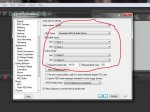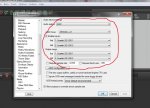Robert27191
New member
Apologies if this is in the wrong section.
*Deep breath*
I have recently bought Focusrite's Scarlett 2i2 interface. Up until now, I have been using an Alesis io2. I ALWAYS have the Audio System set to ASIO.
Now, when I connect the Scarlett, in Options>Preferences>Audio Device, under the 'Asio Driver' tab, I have two options:
One reads 'Asio4All v2' - which is what it said with the Alesis io2.The other option read 'Focusrite USB 2.0 Audio Driver'.
When 'Asio4All vs' is selected, the Inputs and Outputs tabs all read 'Scarlett 2i2 USB 1' or 'Scarlett 2i2 USB 2'.
When 'Focusrite USB 2.0 Audio Driver' is selected, the Input and Output tabs read 'Input 1' or 'Input 2'.
I have attached two screen shots, showing the differences if the above isn't clear. The first picture shows 'Asio4All v2' selected, the second shows 'Focusrite' selected.
Could someone please explain what these options are and which one I should use? I am a fair novice at this and so really don't know which is the one I should go with. Would appreciate any comments.
Many thanks!
Robert


*Deep breath*
I have recently bought Focusrite's Scarlett 2i2 interface. Up until now, I have been using an Alesis io2. I ALWAYS have the Audio System set to ASIO.
Now, when I connect the Scarlett, in Options>Preferences>Audio Device, under the 'Asio Driver' tab, I have two options:
One reads 'Asio4All v2' - which is what it said with the Alesis io2.The other option read 'Focusrite USB 2.0 Audio Driver'.
When 'Asio4All vs' is selected, the Inputs and Outputs tabs all read 'Scarlett 2i2 USB 1' or 'Scarlett 2i2 USB 2'.
When 'Focusrite USB 2.0 Audio Driver' is selected, the Input and Output tabs read 'Input 1' or 'Input 2'.
I have attached two screen shots, showing the differences if the above isn't clear. The first picture shows 'Asio4All v2' selected, the second shows 'Focusrite' selected.
Could someone please explain what these options are and which one I should use? I am a fair novice at this and so really don't know which is the one I should go with. Would appreciate any comments.
Many thanks!
Robert



